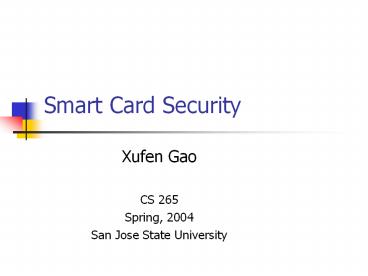Smart Card Security PowerPoint PPT Presentation
Title: Smart Card Security
1
Smart Card Security
- Xufen Gao
- CS 265
- Spring, 2004
- San Jose State University
2
Overview
- Introduction
- Security Technologies
- Physical structure and life cycle
- Communication with the outside world
- Operating system
- Attacks on Smart Card
- Conclusion
3
Introduction
- Smart card is a credit card sized plastic card
embeds an integrated circuit chip. - Smart card provides memory capacity and
computational capabilities. - It is used in the applications that require high
security protection and authentication.
4
Introduction (Cont.)
- Main applications of smart card
- Credit/debit card
- Medical card
- Identification card
- Entertainment card
- Voting card
5
Security Technologies
- Three Points of Views
- Physical Structure and Life Cycle
- Communication with Outside World
- Operating System
6
Physical Structure
- Three basic elements
- A plastic card
- A printed circuit
- An integrated circuit chip
7
Life Cycle of the Smart Card
- Five phases in smart cards life cycle
- Fabrication phase
- Pre-personalization phase
- Personalization phase
- Utilization phase
- End-of-lift phase
- Every phase has its own limitations on
- transferring and accessing data
8
Fabrication Phase
- The chip manufacturer makes and tests the
integrated circuit chip - A unique fabrication key (FK) is added to prevent
chip from modifying - FK stays in the chip until it is assembled into
the plastic card - FK is derived from a master manufacture key
9
Pre-personalization Phase
- Controlled by the card suppliers
- Circuit chip is mounted on the plastic card
- A personalization key (PK) replaces the
fabrication key - A personalization lock VPER is set to prevent
further modification - The card only can accessed by the logical memory
addressing
10
Personalization Phase
- Card issuer writes the data files and application
data to the card - Stores identity of card holder, PIN, and
unblocking PIN - Set a utilization lock VUTIL to indicate the card
is in the utilization phase
11
Utilization Phase
- For normal use of the card by the card holder
- Application system and logical file access
controls are available - There are application security policies to rule
the access of the information
12
End-of-Life Phase
- Also called invalidation phase
- There are two ways to move the card into this
phase - Set an invalidation lock to an individual or
master file. - Operating system disables all operations except
read for analysis - Block all the PINs to disable all operations
- Operating system disables all operations
including read
13
Communication with Outside World
- Smart card usually needs external peripherals to
cooperate - e.g. needs to connect to card acceptor device to
obtain power and input/output information - The untrusted external peripherals reduce the
security
14
Communication with Outside World (Cont.)
- To prevent massive data attack
- Data exchange limits to 9600 bits/second
- Use half duplex mode
- Mutual authentication protocol is used between
smart card and CAD - Use message authentication code (MAC) to protect
integrity
15
Authentication between Smart Card and CAD
16
Operating System
- Logical File Structure
- Access Controls
17
Logical File Structure
- Files are in a hierarchal tree form
- Master file (MF)
- Dedicated file (DF)
- Elementary file (EF)
- Every file has header and body
- Header consists security attributes to indicate
users rights - Body stores all the headers of its immediate
children or data - Application can access files only it has the
appropriate right
18
Access Controls
- Depends on the correct presentation of PIN and
their management - 5 Levels of access conditions
- Always (ALW)
- Card holder verification 1 (CHV1)
- Card holder verification 1 (CHV1)
- Administrative (ADM)
- Never (NEV)
- PIN presentation and management
- Counter
- Maximum number
- Unblocking PIN
19
Attacks on Smart Card
- Logical attacks
- Control the voltage or temperate on EEPROM
- Physical attacks
- Wash away the surface of circuit chip and Examine
it - Use UV light
Logical and physical attacks are expensive. They
are only available in well-funded laboratories.
20
Attacks on Smart Cart (Cont.)
- Functional attacks
- Smart card consists five parties
- Cardholder, terminal, data owner, card issuer,
card manufacturer, and software manufacturer - There are potential attacks between any two
parties - Solutions
- Use strong cryptographic protocols to increase
tamper resistance - Reduce the party number
- Make the system more transparent
- Consider the security issue at the beginning of
the system design
21
Conclusion
- Smart card uses integrated circuit chip rather
than magnetic strip to store data - Smart card can be programmed to compute the
cryptographic keys - Smart card is a good device to store important
information - Private key
- Account numbers
- Biometrics information
- Smart card has weakness, but it is secure enough
for present requirements
22
Q A
???

